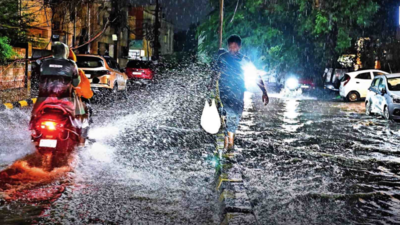ARTICLE AD BOX

A lot needs to be done to make the city monsoon-proof, say TOI readers. For starters, desilt nalas, repair roads, and preserve open spaces to prevent waterlogging and traffic jamsStormwater drains blockedMy apartment is on Street Number 7, Gaganmahal Colony, Domalguda.
The road slopes in my area, which is also the natural flow of water, leads to the Ashoknagar Nala. The concrete road was re-laid two years ago, and it was laid on top of the old road. This has raised the road height in some areas, and the connecting roads are three inches lower than this raised road. What kind of engineering this is, is still a puzzle. The stormwater drains have all been blocked, and the water flows on the road.
Added to that, the footpaths in our area are all occupied, and during rains, pedestrians have to wade in the water on the road. The stormwater drains need to be activated, and the footpaths need to be made accessible for use. Also, the puzzle of raised roads needs to be looked into. — Madhuvanti NeneImprove sanitation infrastructureMany cities, including Hyderabad, are submerged in rainwater, and the main reason for this is the lack of timely cleaning of drains.
Drains are full of garbage, and whenever there is more than usual rainfall, these drains become clogged and flood-like situations arise. In low-lying areas, water enters houses, accumulates, and blocks streets and roads, while stagnant water breeds mosquitoes and other germs, and it becomes impossible to breathe due to stench and bad smell.
There is a dire need to further improve the sanitation system in the old city. — Syed Shamsuddin MaghrabiCreate rain gardensGutters must be cleared at the earliest, and rain gardens must be created by planting more trees to absorb excess water.
Every citizen should have a first aid kit and emergency supplies handy. People should also make it a point to stay away from lowlying areas, underpasses, drainages, and potholes. They should avoid driving, using public transport, and walking in flooded areas. Underground pits should be built to allow water to infiltrate into the ground.
Weather forecasts must be strictly followed along with alerts. No permission must be given for house construction without rainwater harvesting (RWH) pits. — Aravind YadappanavaDon’t open manhole lidsLet the authorities attend to the drainage system in the city before the monsoon commences in a full-fledged manner, as removing the lids of manholes during rains is more dangerous.
The officials should look at permanent solutions, not stop-gap. Every year, the same issues crop up, and each time citizens are worried about moving around during the monsoon. A concrete plan to utilise funds to avoid wasting money is needed as well.
— Mangalampalli Satya Mohan SinghFence lakes, nalasTo better handle monsoon rains, GHMC must complete desilting of all nalas, stormwater drains, and catchpits—and ensure the silt is not left on roadsides.
Encroachments on stormwater channels must be cleared to restore flow. The civic body should also fence lakes and ponds to prevent overflow and accidents. In coordination with Traffic Police, it must prepare diversion plans for flood-prone areas and deploy emergency response teams with pumps, barricades, and first aid kits.
— Srini JakkamFix streetlightsThe entire stretch of Jubilee Hills Road 70 has sunken road stretches, which accumulate water during monsoons. Coupled with a lack of functioning streetlights, this makes it hazardous for a busy road. I am requesting GHMC to fix roads as well as lights. There are no stormwater drains on the road. —Venkat KonaTranslocate old treesMost of the roads in Hyderabad city are filled with potholes, and our drainage needs repairs.
There are many old trees which are vulnerable and can fall at any time, especially during rain. Authorities should check for such trees and the soil condition to ensure that they do not become a problem during rains. If needed, they should be translocated. People living in low-lying areas should make sure there will be a smooth flow of heavy rainwater into the drainage canals.
Proper security covers or railings should be in place near open nalas and drains. — Venkat RudraReplace ageing pipelinesI live in Officers’ Colony, RK Puram, a layout established in 1968 for army families. It now houses 6,000 units and nearly 50,000 residents. The infrastructure is in a poor state. Despite repeated complaints to GHMC for patchwork and to HMWSSB for replacing old pipelines, there has been no progress. — Ramesh SistlaBuild roadside rainwater catchmentsThe city needs major upgrades to face the monsoon.
I travel daily from Meerpet to Rajendranagar, and even a brief shower makes this route—especially through Bandlaguda and Chandrayangutta—chaotic. Rainwater stagnates, sewerage overflows, and eroded sand makes roads slippery, causing accidents. I suggest constructing water catchment pits every 100 metres along roads to prevent flooding and recharge groundwater.
— Ajay KomatineniPreserve open spacesAs the rainy season approaches, it’s time for Hyderabad to prepare.
Every year, we see flooded roads, traffic jams, and damaged homes. Much of this happens because drains are blocked, lakes are encroached, and there’s too much concrete and too little green space. We all must act: Fix drains and keep them clean before the rains start. Encourage rainwater harvesting in homes and buildings. Preserve open spaces and lakes, which help soak up rain.
Spread awareness so people don’t throw waste in drains. The govt should act fast, but we citizens must also do our part. Together, we can reduce flooding and make our city safer during the monsoons. — T Kailash DityaPenalise violatorsDeluge happens when the inlet is bigger than the outlet.
There are norms for the optimum population for a given square kilometre. Town planning should ensure and keep this in mind while approving plans. They should also periodically monitor any disproportionate increase in the density of the population. Increase the diameter of the drainpipes where the population density is huge to facilitate the outflow of water.
Ensure no garbage clogs the stormwater drain. Penalise violators, like commercial establishments, hotels, and eateries. Deploy suction motors in vulnerable areas. Create avenues on all roads to encourage water absorption. — Natarajan SitaramanRoads in bad shapeThe monsoon season is just around the corner, and we should be prepared to face the rains.
A proper drainage system to prevent waterlogging is essential, along with a robust rainwater harvesting system to ensure that water is not wasted. Most importantly, safe road conditions in every locality are necessary to prevent untoward incidents. My neighbourhood is not fully monsoon-ready, particularly concerning proper road conditions.
I live in Sadhana Vihar Colony, Sainikpuri. The residents of this locality generally use the Kapra Lake side road, which connects to the main road. Nowadays, the said road is in very bad shape, with many potholes and open manholes along the stretch. This is already proving to be a major reason for frequent traffic jams. — Ayushman SahaClear clogged drainsThe monsoon season brings with it numerous challenges, including potential flooding and the spread of waterborne diseases.
It also affects our daily lives, causing traffic disruptions and impacting our homes and workplaces. Taking proactive steps can help mitigate these risks and ensure we are better prepared for the rainy season. These steps include ensuring proper drainage, cleaning gutters, and maintaining hygiene.
It is important for individuals, communities, and local authorities to work together to ensure we are well-prepared. This includes raising awareness about monsoon precautions, implementing effective drainage systems, and providing timely alerts. — Nagarajamani MVRecycle wasteThe twin cities are not ready to handle the season's heavy downpour.
Underground sewage pipelines are choked. Water and sewerage pipelines are leaking. Potholes are a common sight on poorly laid-down roads. Above all, waste disposal not properly disposed of will be the biggest threat to the citizens. To start with, GHMC and Secunderabad Cantonment Board must take immediate action to recycle all types of waste to produce alternative fuel, as is being done by advanced countries all over the world.
Shortcuts, as is the practice being adopted by the civic bodies, will not work. The need is to take permanent measures to make our twin city neat, clean, and green. — Brig Jagjit Singh AhujaLevel roads, remove potholesNo doubt, the monsoon has brought a big relief from the soaring temperatures of Hyderabad. But the sudden thought of going to my workplace wading through puddled waters, navigating potholes, and getting stuck in long traffic jams, creates a sense of pure phobia.
Instead of enjoying the beauty of the season, it turns into Monday blues. We are not monsoon-ready. And being monsoon-ready isn’t a one-time event, but a continuous process.
It requires regular desilting of drains, covering of potholes, levelling of roads, and proper garbage clearance, especially before and during the rainy season. Take Himayatnagar, for instance. The interior lanes are full of potholes. Garbage lies congested on the roads. — Chada Rekha RaoWhy not complete repair work in summer?I live in Mylargadda.
Every year, we face waterlogging, inundation, traffic snarls, and loss of life because of opened drainage lids, which is the only solution to prevent inundation. The govt should have repaired roads in summer itself before the onset of the monsoon. Because of potholes, there have been many accidents, especially for two-wheeler drivers. I feel there is no coordination between departments. It looks like the only solution to our problems is to remain at home during the rains.
There is not even a small space left on either side of roads to absorb rainwater, because of which all the water is entering into the cellars of buildings. There is no proper rain harvesting pit in the apartments. — Nagarjuna Srinivasa Rao YenamandraEnsure 24X7 power supplyIt appears Hyderabad is illprepared for the monsoon. Old trees, broken roads, ageing bridges, and open nalas need urgent inspection. Authorities must ensure that rainwater is properly channelled into stormwater drains. Heavy branches of large trees should be trimmed to prevent contact with electric lines, which could cause outages. Uneven and sloping roads should also be repaired without delay. — Jahnavi Venkat



.png)
.png)
.png)
















 1 week ago
4
1 week ago
4









 English (US) ·
English (US) ·